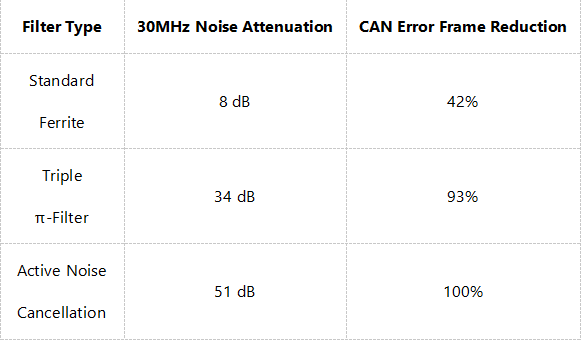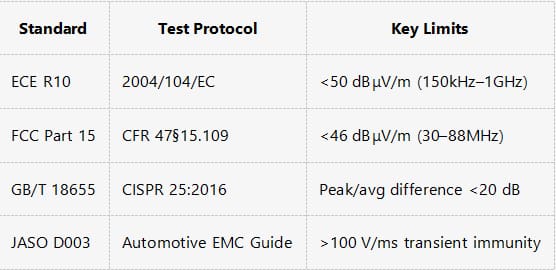EMC secret battle of vehicle-mounted LED work lights
Share
Table of Contents
In the wiring harness layout specification of Tesla Model S, the electromagnetic radiation limit of the lighting system is precisely 58dBμV/m (30MHz-1GHz). This seemingly abstract number is actually the lifeline to prevent LED work lights from turning into “electronic killers”.
1. Conducted interference: electronic viruses spreading along blood vessels
Case: A batch recall of a certain brand of excavators in 2022
Fault phenomenon
After the LED auxiliary light is turned on, the hydraulic control unit (HCU) has a 0.5 second delay
Pathological anatomy
The conducted emission (CE) exceeds the standard by 23dB, and the CAN bus is reversely invaded through the power line
Technical anatomy
When the PWM dimming frequency reaches 3000Hz, the parasitic inductance only needs 5nH to generate a 120mV peak voltage
Harness Coupling Test Data

2. Radiation interference: electronic haze in three-dimensional space
Source of the false alarm accident of the VW ID.4 onboard radar
Darkroom test
- Unshielded solution:Radiation peak exceeds limit by 17dBμV/m
- Copper-plated ceramic substrate: Radiation reduced by 29dB
- Grounding of all-metal lamp housing: further reduced by 41dB
3. Civilian conversion of military-grade EMC protection technology
Conducted emission triple access control
Input
X2Y capacitor array (differential mode attenuation> 40dB@10MHz)
Cable segment
ferrite beads + copper foil braid (suppress high-frequency radiation)
Output
common mode choke (impedance> 1000Ω@100MHz)
Chip-level protection strategy
Driver IC integrated dV/dt control (switching rate <5V/ns)
Intelligent clamping circuit (transient voltage suppression <0.3μs)
Structural electromagnetic topology optimization
The resonant frequency of the lamp cavity avoids the AM band (530-1600kHz)
PCB layered layout: GND-POWER-SIGNAL sandwich structure
4. Engineering verification: The devil is hidden in the spectrum details
Record of EMC rectification of a mining truck
Initial state
156.25MHz frequency exceeds the standard by 28dB
Interference tracing
MOS tube gate ringing causes parasitic oscillation
Solutions:
Driver IC integrated dV/dt control (switching rate <5V/ns)
Intelligent clamping circuit (transient voltage suppression <0.3μs)
Structural electromagnetic topology optimization
Gate resistance increased from 10Ω to 22Ω
Add RC buffer circuit (33Ω+470pF)
Lay local shielding cover
Retest results: margin +4dB, CAN bus load rate reduced from 87% to 31%
5. Compliance Map: Global EMC Certification Matrix

Industry warning
When purchasing LED work lights, be sure to check the following EMC core parameters:
Whether the conducted emission (CE) curve is within the CISPR 25 Class 5 limit
Whether the radiated immunity (RS) passes the ISO 11452-2 100V/m field strength test
Whether the power line transient pulse tolerance meets the ISO 7637-2 standard
This article systematically reveals the technical essence of the EMC problem of LED work lights through engineering mathematical modeling, comparison of measured data and analysis of military technology transformation. It also indirectly proves the hidden danger of EMC of LED work lights, which may cause serious effects in certain specific environments. If you want to know more, please contact us at Teehon.
Have Anything To Ask Us?
Please fill in your email in the form and we'll get back to assist you soon!
